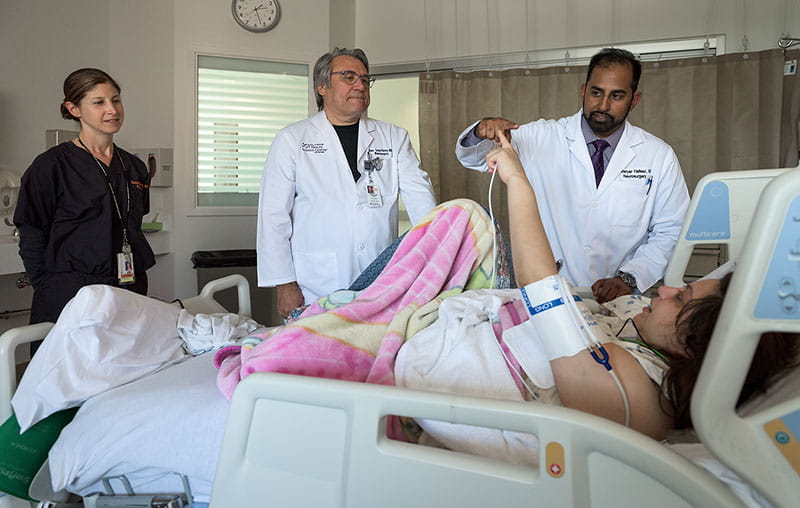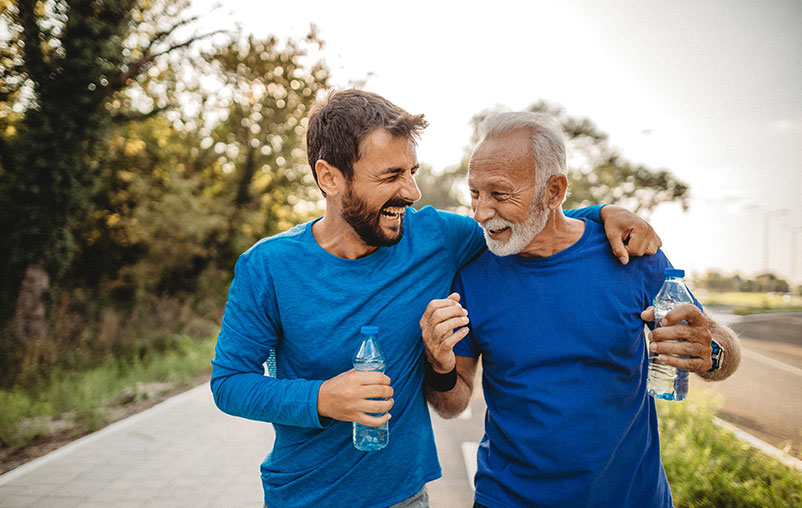Stroke
A stroke occurs when blood flow to the brain is blocked. When blood can’t get to the brain, brain cells begin to die within minutes.
There are two types of stroke:
- Ischemic stroke occurs when a blood clot blocks blood flow to your brain
- Hemorrhagic stroke occurs when a broken blood vessel leaks blood into the brain
No matter the type, a stroke needs immediate medical help.
Risk Factors for Stroke
Stroke can happen in people of any age, sex or race. You can control some stroke risk factors but not others. These conditions may increase your risk for stroke:
- High blood pressure
- High cholesterol
- Smoking
- Being overweight
- Diabetes
Some risk factors you can’t change include:
- Age – Your stroke chances increase with age.
- Sex – Stroke is more common in men but kills more women than men.
- Family history – If your parents, grandparents or siblings have had a stroke, your risk is higher.
- Race – Those who are Black and Hispanic have strokes more often and at a younger age than those who are white.
- Stroke or heart attack history – If you have had a stroke or heart attack before, your chances of having another stroke go up.
Stroke Prevention
You can make lifestyle changes to prevent stroke, such as:
- Being physically active
- Eating a healthy diet
- Checking your blood pressure often
- Limiting alcohol use
- Maintaining a healthy weight
- Reducing stress, which contributes to unhealthy behaviors
- Quitting smoking or vaping
You can also reduce your risk by getting medical care for health conditions that contribute to stroke. Work with your doctor to treat and manage health conditions such as high blood pressure, diabetes, heart disease and sleep apnea. Schedule an appointment with a University Health primary care provider.
It takes a team to help you get better after a stroke because it can cause long-term disability. Most patients need rehabilitation. That means working with therapists and physicians who help you regain lost skills.
Treatment Options after Stroke
There are several treatment options for patients for long-term disability from strokes including:
- Inpatient rehabilitation
- Casting
- Therapy
- Interventional therapies
- Robotic therapies
Know the Signs & Act in Time
Learn about the signs of stroke and the importance of fast emergency treatment.
BE FAST is an acronym used to know the signs of stroke. The letters stand for:
B – Balance
The person may suddenly have trouble with balance or coordination.
E – Eyes
They could experience sudden blurred, double or total loss of vision. This can happen in one or both eyes.
F – Face
Do you notice one side of their face drooping? Ask the person to smile.
A – Arms
Are they experiencing weakness in one arm? If they raise both arms, does one drift down?
S – Speech
Is speech slurred, are they unable to speak or are they hard to understand? Ask the person to repeat a short sentence like, “Remember the Alamo.” Do they repeat the sentence correctly?
T – Time to get help
If you notice any of these symptoms, call 911 and get the person to a hospital immediately.
Stroke in Bexar County
Stroke is a big health concern in Bexar County and the United States. Stroke is the fifth leading cause of death in the U.S., according to the American Heart Association’s 2023 Update [PDF]. In 2020, someone died of a stroke every 3 minutes and 17 seconds on average.
The stroke death rate in Bexar County for people aged 35 and older was 88 per 100,000 people from 2018 to 2020. This is higher than the state of Texas (78) and the nation (73).
In Bexar County, Black people had the highest death rate from stroke: 103 per 100,000. Hispanic people had a rate of 89, and White people had a rate of 84.
The 2022 Bexar County Community Health Needs Assessment [PDF] shows the percentage of adults who have ever received a diagnosis of a stroke. The percent in the Near Eastside sector was much higher at 16% than in other areas. The next highest were the Near Westside at 6% and the Southwest at 5%.
University Health Resources
Primary Care
University Health primary care providers can provide preventive health screenings and services to those at a higher risk for stroke. Quitting smoking and managing other health conditions like heart disease can help lower your risk for stroke.
Stroke Care
University Health is a Comprehensive Stroke Center. This means if you or a loved one has a stroke, our expert neurologists are ready to provide the highest level of care and rehabilitation.
From day 0 until discharge from the hospital, there are multidisciplinary teams caring for the patient from vascular neurologists, neurosurgeons, physiatrists, therapists, pharmacists, nursing and care management teams.
After the hospitalization, patients are followed up in stroke clinic soon after for continuity of care with dealing with post stroke sequela and secondary stroke prevention.
Stroke Rehabilitation
University Health has comprehensive inpatient rehabilitation and outpatient services through a joint collaboration with PAM Health Warm Springs Rehabilitation for inpatient and outpatient therapies of physical therapy, occupational therapy and speech therapies. A robotic exoskeleton is also available for some stroke survivors.
Stroke Support Group
As a Certified Stroke Center, University Health invites stroke survivors and their guest to join the monthly stroke support group meetings. You can attend virtually or in person for support and education.
Community Resources
Online Support Network
You can use this online resource from the American Stroke Association to connect with stroke survivors and families all over the country. The Online Support Network gives you emotional support and encouragement. You can also share experiences and give feedback to others.
PAM Health Warm Springs Rehabilitation Hospitals
PAM Health Warm Springs Rehabilitation Hospitals partners with University Health to help you recover from conditions like stroke. The locations are in the Medical Center, Northeast San Antonio and Westover Hills.
Stroke Family Warmline
This American Stroke Association program helps stroke survivors, their families and caregivers. Call the Stroke Family Warmline (1-888-478-7653) for resources, information, aftercare and emotional support.
Stroke Survivors Fund
The Stroke Foundation provides a fund for stroke survivors to help cover therapy costs.
Check Your Health



